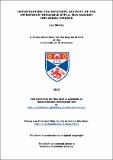Files in this item
Investigating the antiviral activity of the interferon-inducible GTPase MxA against influenza viruses
Item metadata
| dc.contributor.advisor | Jackson, David | |
| dc.contributor.author | Sherry, Lee | |
| dc.coverage.spatial | xvi, 300 p. | en_US |
| dc.date.accessioned | 2016-01-25T14:39:44Z | |
| dc.date.available | 2016-01-25T14:39:44Z | |
| dc.date.issued | 2016-06-22 | |
| dc.identifier | uk.bl.ethos.678187 | |
| dc.identifier.uri | https://hdl.handle.net/10023/8072 | |
| dc.description.abstract | The interferon (IFN) system forms an essential part of the innate immune response, up-regulating hundreds of IFN-stimulated genes (ISGs) in response to viral infection. A key protein in this response is the human myxovirus resistance protein MxA, an IFN-induced GTPase with broad-spectrum antiviral activity, capable of inhibiting many RNA and DNA viruses. One of the most studied antiviral effects of MxA is the inhibition of influenza A virus replication, yet the molecular mechanism of antiviral activity is still unknown. Influenza A viruses are inhibited by MxA at two distinct stages of viral replication; during viral entry and following primary transcription of viral mRNAs. The antiviral effects of MxA during viral entry are highly dependent on IFN, however activity exerted after primary transcription can occur in the absence of IFN. This study provides evidence that MxA exerts its antiviral activity at these two stages of viral replication through distinct mechanisms, and outlines a potential model of MxA antiviral activity following primary transcription. A potential third antiviral mechanism of MxA is proposed based on the findings that MxA is able to regulate cellular lipid metabolism, thereby potentially affecting virion composition. Mutational analysis of MxA highlights the significance of GTPase activity to the antiviral effects of MxA, while also demonstrating that natural single nucleotide polymorphisms in MxA have the potential to severely impair or prevent antiviral activity. Finally, this thesis shows for the first time that MxA exhibits antiviral activity against influenza B viruses. Overall this thesis provides new information illustrating how MxA provides potent antiviral activity against influenza viruses. Such information is vitally important as understanding the molecular basis of how proteins such as MxA function against many human pathogens is fundamentally important in our efforts to create better long-term treatment options for all viral diseases. | en_US |
| dc.language.iso | en | en_US |
| dc.publisher | University of St Andrews | |
| dc.rights | Creative Commons Attribution-ShareAlike 4.0 International | |
| dc.rights.uri | http://creativecommons.org/licenses/by-sa/4.0/ | |
| dc.subject | Virology | en_US |
| dc.subject | Interferon | en_US |
| dc.subject | Influenza A virus | en_US |
| dc.subject | Influenza B virus | en_US |
| dc.subject | Interferon stimulated gene | en_US |
| dc.subject | MxA | en_US |
| dc.subject.lcc | QR389.S6 | |
| dc.title | Investigating the antiviral activity of the interferon-inducible GTPase MxA against influenza viruses | en_US |
| dc.type | Thesis | en_US |
| dc.contributor.sponsor | Medical Research Council (MRC) | en_US |
| dc.type.qualificationlevel | Doctoral | en_US |
| dc.type.qualificationname | PhD Doctor of Philosophy | en_US |
| dc.publisher.institution | The University of St Andrews | en_US |
This item appears in the following Collection(s)
Except where otherwise noted within the work, this item's licence for re-use is described as Creative Commons Attribution-ShareAlike 4.0 International
Items in the St Andrews Research Repository are protected by copyright, with all rights reserved, unless otherwise indicated.


